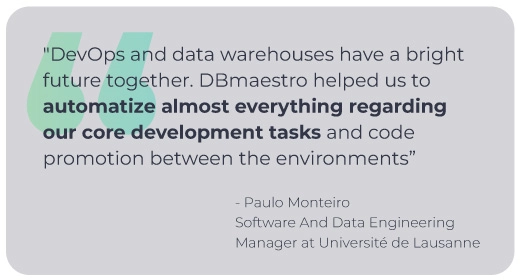Understanding Secure Database DevOps
Secure database DevOps involves incorporating security measures throughout the entire development lifecycle, from planning and coding to testing, deployment, and maintenance. This approach helps prevent data breaches, maintain compliance, and ensure system integrity by addressing security concerns at every stage of the process.
The Importance of Security in DevOps for Databases
Integrating security into DevOps is essential for several reasons:
- Preventing data breaches: By embedding security practices into the development process, organizations can identify and address vulnerabilities early, reducing the risk of data breaches.
- Maintaining compliance: Secure database DevOps helps ensure adherence to regulatory requirements and industry standards, avoiding costly penalties and reputational damage.
- Ensuring system integrity: By implementing security measures throughout the development lifecycle, organizations can maintain the integrity of their database systems, preventing unauthorized access and data manipulation.

Why Traditional Database Security Approaches No Longer Work
Traditional security models often rely on perimeter-based defenses and periodic security audits. However, these approaches are insufficient in modern DevOps environments due to:
- Rapid development cycles
- Frequent deployments
- Distributed systems and cloud-based infrastructure
- Increasing sophistication of cyber threats
The Intersection of Security and DevOps: Why It Matters
Integrating security into DevOps, often referred to as DevSecOps, allows organizations to:
- Identify and address security issues early in the development process
- Automate security testing and compliance checks
- Foster collaboration between development, operations, and security teams
- Maintain agility while enhancing overall security posture
Common Security Challenges in Database DevOps
Some key risks in database DevOps include:
- Misconfigurations leading to exposed data
- Unpatched vulnerabilities in database systems
- Weak access controls and privilege management
- Insecure CI/CD pipelines that can introduce vulnerabilities
- Lack of visibility into database activities and changes
Best Practices for Secure Database DevOps
To embed security into DevOps processes without disrupting agility and performance, consider the following best practices:
Implementing DevSecOps for Continuous Security
DevSecOps ensures that security is integrated into every stage of the database DevOps pipeline. This approach involves:
- Conducting security assessments during the planning phase
- Implementing secure coding practices and code reviews
- Automating security testing as part of the CI/CD pipeline
- Continuously monitoring for security threats and vulnerabilities
Automating Database Security Policies and Compliance Checks
Leverage automation tools to enforce security policies, detect vulnerabilities, and ensure regulatory compliance. This can include:
- Automated vulnerability scanning
- Configuration management tools to enforce security baselines
- Compliance checking tools to ensure adherence to regulatory standards

Role-Based Access Control (RBAC) and Least Privilege Access
Implement RBAC and least privilege principles to minimize security risks by restricting access to databases based on user roles. This involves:
- Defining clear roles and responsibilities
- Granting minimal necessary permissions for each role
- Regularly reviewing and updating access controls
Continuous Monitoring and Threat Detection
Utilize real-time monitoring and AI-driven threat detection to identify security breaches proactively. This can include:
- Database activity monitoring (DAM) tools
- Security information and event management (SIEM) systems
- User and entity behavior analytics (UEBA) to detect anomalies
Essential Tools for Secure Database DevOps
To implement secure database DevOps effectively, consider a tool like DBmaestro which provides the following:
- Security scanners for identifying vulnerabilities
- CI/CD security integrations for automated testing
- Database auditing solutions for tracking changes and access
- Cloud security frameworks for protecting cloud-based databases
Key Takeaways
- Integrate security throughout the entire database DevOps lifecycle.
- Automate security testing and compliance checks to maintain agility.
- Implement role-based access control and least privilege principles.
- Utilize continuous monitoring and threat detection tools.
- Foster collaboration between development, operations, and security teams.
Conclusion
Secure database DevOps is essential for building resilient systems that can withstand the evolving threat landscape while maintaining the agility required in modern development environments. By integrating security practices throughout the DevOps lifecycle, organizations can significantly reduce the risk of data breaches, ensure compliance, and maintain the integrity of their database systems.
To implement secure database DevOps successfully, organizations must embrace a culture of security awareness, leverage automation tools, and foster collaboration between teams. By doing so, they can create a robust security posture that adapts to new threats while enabling continuous innovation and delivery.
Leveraging DBmaestro for Secure Database DevOps
For organizations looking to automate, secure, and govern their database CI/CD pipelines, DBmaestro offers a comprehensive solution. With features such as database release automation, security and compliance automation, and source control, DBmaestro integrates seamlessly into existing DevOps toolchains. It supports compliance with regulations like GDPR, SOX, and HIPAA, ensuring that databases meet stringent regulatory standards. By leveraging DBmaestro, organizations can accelerate database releases, mitigate risks, and improve quality while maintaining a high level of security and compliance.
Ready to enhance your database DevOps security? Explore DBmaestro’s solutions for automated database deployments and security management. Contact us today to learn how we can help you build more resilient database systems.
]]>
At the heart of this transformation is the need for greater collaboration, speed, and efficiency in database development and release management. Organizations are no longer operating in an environment where databases are managed in isolation; they are part of a broader DevOps strategy where multiple personas, including DBAs, data architects, developers, project managers, data scientists, and security teams, contribute to database evolution.
The “Romantic Era” of Databases
In the early days of database management, DBAs reigned supreme. Database changes were carefully planned, executed manually using SQL commands, and rigorously controlled to prevent errors. This centralized approach provided significant advantages:
- Strict Change Control: Only authorized DBAs could implement modifications, ensuring a high level of oversight.
- Minimal Stakeholders: Fewer people had access, reducing the risk of conflicting changes or errors.
- Predictability and Stability: Database updates followed a slow, methodical process, ensuring reliability.
However, as businesses demanded faster time-to-market, real-time insights, and increased agility, this traditional model began to show cracks. The rigidity of the “Romantic Era” led to significant bottlenecks, slowing down innovation and making it difficult for organizations to keep pace with modern development cycles.
Additionally, organizations faced long queues for database changes, as DBAs struggled to keep up with the demand. Changes could take weeks—or even longer—to implement, making it impossible for businesses to respond quickly to market shifts. Attempts to speed up the DBA-driven change process often resulted in errors, security vulnerabilities, and even costly downtime. This inability to adapt swiftly hindered true agility, placing companies at a disadvantage in today’s competitive landscape.

The Modern Agile Era: A Multi-Stakeholder Landscape
Today, databases are no longer the sole domain of DBAs. Instead, they have become an integral part of a broader data ecosystem involving:
- Developers: Making frequent schema changes as part of CI/CD pipelines.
- QA Teams: Working with multiple database versions for testing.
- Data Scientists and AI Modelers: Accessing and modifying data for analytics and machine learning.
- Project Managers: Overseeing releases and ensuring business objectives align with technical changes.
- Security Teams: Ensuring compliance with regulatory requirements.
This shift has necessitated careful collaboration among these distributed stakeholders, many of whom operate across different time zones, teams, and business units. Without the right coordination and governance, multiple teams working on the same database risk introducing conflicts, inconsistencies, and security gaps.
This evolution has led to several critical challenges:
- Version Control Issues: With multiple teams accessing databases, keeping track of different versions for testing, reporting, and AI modeling has become complex.
- Increased Security Risks: More users with database credentials mean a higher risk of unauthorized changes and potential data breaches.
- Collaboration Bottlenecks: Without proper tools, multiple teams working on the same database can create conflicts and inefficiencies.
- Regulatory Compliance Challenges: Organizations must ensure that database changes align with industry standards like GDPR, HIPAA, and SOX.
DBmaestro: A Multi-Constituency Platform for Database DevOps
To address these challenges, organizations need a platform that enables seamless collaboration, automation, and governance. DBmaestro provides a multi-constituency platform, offering significant value across multiple personas by:
- Facilitating Collaboration Across Teams
- DBmaestro ensures that developers, DBAs, QA teams, and security professionals can work together without stepping on each other’s toes.
- It provides a structured workflow that allows changes to be reviewed, approved, and implemented efficiently.
- Role-based access controls ensure that only authorized stakeholders can make modifications, reducing risks associated with unauthorized access.
- Automating Database Release Management
- The platform streamlines database deployments by automating version control, change tracking, and release processes.
- This reduces human errors, eliminates bottlenecks, and accelerates development cycles.
- Continuous integration and delivery (CI/CD) principles are extended to database management, aligning it with modern DevOps best practices.
- Enhancing Security and Compliance
- DBmaestro enforces strict role-based access controls, ensuring that only authorized personnel can make changes.
- It provides an audit trail for all modifications, ensuring compliance with industry regulations.
- Organizations can easily track, review, and approve changes before they are deployed, reducing the risk of compliance violations.
- Reducing Risks and Conflicts
- By providing visibility into database changes, DBmaestro minimizes the risk of conflicting updates.
- The platform integrates with DevOps toolchains, ensuring that database changes align with application releases.
- Automated conflict resolution mechanisms help mitigate potential database schema drift.
The Future of Database Management
As organizations continue to modernize their database operations, the need for platforms like DBmaestro will only grow. The days of the isolated DBA controlling all database changes are long gone. Instead, we are in an era where databases must be agile, collaborative, and secure.
DBmaestro is at the forefront of this revolution, providing a comprehensive solution that empowers multiple stakeholders while maintaining control, security, and efficiency. The result is a faster, more reliable, and risk-free approach to database DevOps, ensuring that businesses can innovate without compromising their data integrity.
Conclusion
The evolution from the “Romantic Era” of database management to today’s Agile era marks a fundamental shift in how organizations handle data. With multiple stakeholders requiring access, the risks and complexities have increased exponentially. However, with the right tools and methodologies, businesses can navigate this new landscape successfully.
DBmaestro’s multi-constituency platform bridges the gap between database governance and agility, enabling teams to work together efficiently while maintaining security and compliance. As organizations continue to embrace digital transformation, ensuring that database management keeps pace with innovation will be critical for success.
In this fast-moving world, one thing is clear: the era of rigid, DBA-only database management is over. The future belongs to those who can embrace automation, collaboration, and security in their database operations.
]]>Understanding RegTech and Its Importance in Compliance
RegTech refers to the use of technology to manage regulatory processes within the financial industry. It helps organizations comply with financial, data protection, and security regulations by automating compliance tasks, improving risk management, and enhancing data handling capabilities.
The Growing Need for Database Automation in RegTech
As regulatory requirements continue to increase in complexity and volume, the need for automated database solutions has become more pressing. Manual compliance processes are no longer sufficient to handle the vast amounts of data and intricate regulatory frameworks that organizations must navigate.

How Database Automation Enhances RegTech Compliance
Database automation optimizes compliance efforts and reduces manual errors through several key mechanisms:
Automating Compliance Audits and Reporting
Automation streamlines regulatory reporting and creates comprehensive audit trails. This ensures that all compliance-related activities are accurately documented and easily accessible for auditors.
Continuous Monitoring for Regulatory Compliance
Real-time monitoring tools help identify and mitigate compliance risks by constantly analyzing data and flagging potential issues before they escalate.
Policy-Based Automation for Security and Access Control
Automated policies enforce data security and prevent unauthorized access, ensuring that sensitive information is protected in accordance with regulatory requirements.

Key Benefits of RegTech Database Automation
Implementing database automation in RegTech offers several advantages:
- Reduced compliance costs: Automation significantly lowers operational expenses associated with compliance management.
- Enhanced operational efficiency: By streamlining processes, automation frees up resources for strategic initiatives.
- Improved accuracy: Automated systems minimize human errors, ensuring more precise compliance reporting.
- Real-time compliance: Automation enables organizations to stay compliant with up-to-the-minute regulatory changes.
- Scalability: RegTech solutions can easily adapt to business growth and evolving regulatory landscapes.
Best Practices for Implementing Database Automation in RegTech
To effectively integrate automation into compliance strategies, consider the following steps:
- Assess your current compliance processes and identify areas for automation.
- Choose database automation tools that align with your specific regulatory requirements.
- Implement a phased approach, starting with critical compliance tasks.
- Provide comprehensive training to staff on new automated systems.
- Regularly review and update automation processes to ensure ongoing compliance.
Key Takeaways
- Database automation is essential for effective RegTech implementation.
- Automation enhances compliance accuracy, efficiency, and cost-effectiveness.
- AI and ML technologies further improve predictive compliance capabilities.
- Implementing best practices ensures successful integration of automation in RegTech strategies.
Conclusion
In conclusion, database automation stands as a pivotal element in modern RegTech strategies, transforming how organizations approach and manage regulatory compliance. By embracing advanced technologies and automated processes, businesses are not only able to stay ahead of increasingly complex and stringent regulatory requirements but also to achieve significant operational improvements. The shift from manual, error-prone processes to automated, efficient systems allows for real-time monitoring, enhanced data integrity, and substantial cost reductions. As the regulatory landscape continues to evolve, the role of database automation will only become more critical. Organizations that proactively integrate these solutions will be better positioned to navigate the challenges of compliance, ensuring they remain secure, efficient, and in full adherence to all applicable regulations.
To learn more about how database automation can enhance your RegTech compliance efforts, explore DBmaestro’s database automation solutions and discover how our Database DevOps platform can help you achieve seamless regulatory compliance.
]]>As a senior developer, I’ve relied heavily on Entity Framework (EF) to streamline database interactions in my applications. At first, it seemed like the perfect solution—object-oriented programming, automatic migrations, and less manual SQL scripting. However, as our application scaled and became more complex, the cracks started to show.
Here are the key challenges I faced using ORM tools like EF for database migrations and how they impacted our workflow:
- Abstraction Overhead – ORM automates schema updates, but I often had no idea what was happening under the hood. This led to unpredictable behaviour, inefficient queries, and schema modifications I didn’t anticipate.
- Complex Schema Changes – Simple column additions worked fine, but anything beyond that—splitting tables, handling massive data transformations, or restructuring indexes—was a nightmare.
- Performance Issues – EF-generated queries were sometimes far from optimal, leading to slow application performance. Our DBA pointed out redundant joins and missing index optimizations that weren’t easily fixable.
- Versioning and Rollbacks – Rolling back a migration was cumbersome. If a change caused an issue, reverting required manually patching the database, as EF’s rollback mechanism wasn’t always reliable.
- Development Workflow Conflicts – Our database was managed by a dedicated DBA team, and ORM-generated schema changes often clashed with their carefully designed schema policies.
- Testing and Validation Gaps – Testing auto-generated migrations was difficult, making it risky to push updates to production without extensive manual validation.
- Team Collaboration Barriers – Not every team member was comfortable with ORM-based migrations, leading to a disconnect between developers and DBAs who preferred raw SQL and scripted migrations.
At this point, I knew we needed a better way. That’s when I discovered DBmaestro.

How DBmaestro Solved My ORM Woes
When I first reached out to DBmaestro, I was sceptical. I had already invested years into our ORM-based workflow, and I wasn’t looking to abandon it entirely. However, the DBmaestro team showed me how their Database DevSecOps solution enhanced my ORM investment rather than replacing it. Here’s how DBmaestro addressed every challenge I was facing:
- Eliminating Abstraction Overhead
DBmaestro’s Database Release Automation gave me full visibility into schema changes. Instead of blindly trusting EF to handle updates, DBmaestro provided a visual change tracking interface, allowing me to review and approve every modification before deployment. This ensured that our database changes were always intentional and efficient.
- Handling Complex Schema Changes with Ease
DBmaestro allowed us to script and version even the most complicated database changes, integrating seamlessly with our ORM. Instead of fighting EF’s limitations, we used custom migration scripts within DBmaestro to handle intricate modifications while keeping ORM-generated changes in check.
- Optimizing Performance with Smart SQL Handling
With automated SQL optimization and best practice enforcement, DBmaestro ensured that no poorly generated ORM queries made it to production. We could inspect and refine every query before deployment, preventing ORM inefficiencies from bogging down our system.
- Bulletproof Versioning and Rollbacks
DBmaestro introduced a Git-like version control system for database changes. If an ORM migration went sideways, I could simply roll back to the previous version with a single click—no more manually patching production databases.
- Aligning Development with DBA Best Practices
Instead of ORM-generated migrations clashing with DBA policies, DBmaestro acted as a governance layer, ensuring that all changes complied with our organization’s standards. Developers could still work with EF, but DBmaestro ensured that changes met DBA approvals before deployment.
- Enhancing Testing and Validation
DBmaestro’s automated testing framework allowed us to validate database migrations before they reached production. We could set up test environments where schema changes were executed and assessed, eliminating last-minute surprises.
- Enabling Seamless Team Collaboration
With DBmaestro, we finally had a solution that worked for both developers and DBAs. Developers continued using EF for day-to-day operations, while DBAs used DBmaestro’s release automation and compliance features to maintain control and governance. This created a unified workflow where both teams could work together efficiently.
Final Thoughts: A New Era for ORM and Database DevSecOps
After integrating DBmaestro into our workflow, our database management process became far more reliable, predictable, and efficient. Rather than abandoning ORM, we enhanced it with DBmaestro’s automation, compliance, and governance capabilities.
The benefits were immediate:
- Faster deployments with controlled schema changes
- Reduced risk through versioned rollbacks and automated testing
- Improved performance with optimized SQL execution
- Stronger collaboration between development and DBA teams
- Seamless cross-database support for a more scalable architecture
Most importantly, DBmaestro helped us get the best ROI out of our ORM investment. Instead of being trapped by its limitations, we leveraged DBmaestro to overcome its weaknesses while keeping its strengths.
If you’re struggling with ORM-based database migrations, don’t abandon your ORM—supercharge it with DBmaestro. It transformed the way we manage database changes, and I’m confident it can do the same for you.
]]>Here are five major challenges in database management and how DBmaestro can help overcome them.”
-
Data Security and Compliance Risks
With regulations like GDPR, HIPAA, and SOX, enterprises face heightened data security requirements and potential penalties for non-compliance. As databases store sensitive and business-critical information, enforcing compliance through effective database management is crucial. According to IBM’s 2023 Cost of a Data Breach report, the average cost of a data breach reached $4.45 million, with even greater costs in sectors like finance and healthcare due to compliance requirements.
DBmaestro’s Database DevSecOps platform enforces security policies and access controls at every stage of database deployment, providing continuous compliance and reducing security vulnerabilities. Its automated policy checks ensure that every database change complies with industry standards and internal protocols. With DBmaestro, organizations can set up customized compliance workflows, ensuring they adhere to regulations without hindering productivity. The platform’s comprehensive audit logging and monitoring also streamline compliance reporting, reducing the need for extensive manual checks and database audits.
How DBmaestro Addresses This Challenge:
- Enforces role-based access controls and automated policy checks.
- Provides continuous compliance with audit logs and monitoring.
- Offers customizable compliance workflows for specific regulations like GDPR and SOX.
-
Siloed Development and Operations Teams
Traditional database management often operates in silos, with separate teams managing development, operations, and security tasks, leading to miscommunication, deployment delays, and reduced agility. According to Puppet’s 2023 State of DevOps Report, only 10% of organizations achieved high DevOps maturity, with persistent silos being a primary obstacle.
DBmaestro bridges these silos by enabling a collaborative Database DevSecOps approach. Its platform integrates workflows across development, security, and operations teams, aligning database changes with application release cycles. By facilitating transparent workflows, DBmaestro promotes real-time collaboration and keeps all teams informed on database changes. This alignment accelerates project delivery and improves database deployment efficiency while preserving high levels of control and security.
How DBmaestro Addresses This Challenge:
- Integrates workflows across DevOps, security, and database teams for seamless collaboration.
- Provides transparency and real-time updates on database changes.
- Promotes unified workflows, improving communication and reducing deployment delays.

-
Slow Release Cycles and Deployment Bottlenecks
A key benefit of DevOps is the ability to deploy quickly and frequently. However, database release cycles often lag due to manual processes and database complexity. DORA’s 2023 report found that high-performing organizations release code multiple times per day, while lower performers may release only once every few months. Database release cycles must keep pace with these demands.
DBmaestro automates database release processes, enabling enterprises to achieve faster, more frequent deployments without sacrificing security or accuracy. Its CI/CD automation features streamline approvals, testing, and deployment, helping organizations deploy database changes as quickly as application code. DBmaestro’s Source Control capabilities also reduce bottlenecks by automating code merging and conflict resolution, ensuring smooth deployments even in highly dynamic environments.
How DBmaestro Addresses This Challenge:
- Automates database CI/CD pipelines, reducing deployment times.
- Offers end-to-end Source Control module to streamline database versioning and conflict resolution.
- Synchronizes database releases with application release cycles, enabling frequent, reliable deployments.
-
Lack of Visibility and Traceability in Database Changes
Visibility and traceability are vital for managing database changes, maintaining configuration integrity, and ensuring accountability. Yet, many organizations struggle with tracking changes across multiple teams and environments. According to Gartner, 65% of companies lack adequate visibility into database change management processes, creating risks for data integrity and compliance.
DBmaestro addresses these concerns by providing end-to-end visibility and traceability of all database changes. Its detailed audit trail records every database modification, who made it, and when. The platform’s change management system ensures that every update is reviewed and approved before deployment, reducing unauthorized changes and errors. Moreover, DBmaestro’s analytics capabilities provide true insights into database change processes, helping teams detect and resolve issues before they impact operations.
How DBmaestro Addresses This Challenge:
- Provides detailed audit trails for every database change.
- Ensures all changes go through a strict approval and review process.
- Offers full blown observability module to track team and individuals performance insights to maintain database health and increase team efficiency.

-
Increased Risk of Human Errors
Database management traditionally relies on manual processes, creating a higher risk of human error. These errors can compromise data integrity, disrupt workflows, and lead to costly downtime. Research from IBM shows that 95% of cybersecurity breaches are due to human error, highlighting the need for automation and controlled processes.
DBmaestro’s Database DevSecOps platform minimizes human error by automating repetitive tasks and enforcing standardized workflows. Its database Source Control module enables database schema management and eliminates accidental overwrites and unauthorized modifications. Automated conflict resolution and approval workflows further reduce the need for manual intervention, ensuring that database updates are accurate, secure, and aligned with business requirements.
How DBmaestro Addresses This Challenge:
- Automates repetitive tasks, reducing reliance on manual processes.
- Enforces structured workflows for change approvals and version control.
- Minimizes the risk of configuration drift and accidental changes with automated checks.
DBmaestro: Bridging the Gaps in Database DevSecOps
As a leading Database DevSecOps platform, DBmaestro provides enterprises with the tools to manage, secure, and accelerate database workflows in today’s DevOps-driven environments. DBmaestro not only addresses these top five challenges but also aligns database management with modern DevOps practices, enabling organizations to move faster while keeping data secure and compliant.
Some of DBmaestro’s standout features that empower enterprises include:
- Policy-Driven Security: DBmaestro allows organizations to implement security policies that enforce access control and data protection at every stage of the database lifecycle. This ensures that only authorized personnel can make changes, and all updates meet regulatory requirements.
- End-to-End Database Release Automation: From code review to production deployment, DBmaestro automates database release processes to keep pace with application development. This reduces deployment delays and enables continuous integration, even in complex database environments.
- Advanced Collaboration Tools: DBmaestro’s collaboration features foster a DevSecOps culture, helping teams across development, operations, and security work together seamlessly. This removes silos, improves efficiency, and builds a culture of shared responsibility.
- Comprehensive Auditing and Monitoring: With DBmaestro’s detailed logging and monitoring, organizations gain full visibility over their database operations. The platform’s compliance reports and audit trails make it easy to demonstrate regulatory compliance, reducing the burden of manual reporting.
By helping organizations tackle these challenges, DBmaestro enables enterprises to achieve true Database DevSecOps, where databases are managed as an integrated part of the software delivery pipeline. With the benefits of speed, security, and compliance, organizations can innovate faster, enhance their customer experiences, and remain competitive in today’s rapidly evolving digital landscape.
Conclusion
The rise of Database DevSecOps has been transformative, especially in addressing the unique challenges that come with database management. Organizations striving to secure data, ensure compliance, reduce human errors, and accelerate release cycles can turn to DBmaestro as a comprehensive solution that closes these gaps and empowers teams to meet their goals effectively.
DBmaestro not only tackles today’s pressing database management challenges but also prepares organizations for the future by promoting a culture of collaboration, security, and innovation. As a result, enterprises that adopt Database DevSecOps with DBmaestro are better positioned to meet industry demands, optimize their database workflows, and drive business growth through agile, secure, and compliant data management practices.
]]>
What You Will Learn
In this blog post, you will discover:
- The definition and significance of DevOps observability in modern software development.
- Key differences between observability and monitoring, and how they complement each other.
- The three main pillars of observability: logs, metrics, and traces.
- Best practices for implementing effective DevOps observability strategies.
What is DevOps Observability?
DevOps observability refers to the ability to understand and analyze the internal state of a system based on its external outputs. It goes beyond traditional monitoring by providing a more comprehensive view of the entire system, allowing teams to quickly identify and resolve issues, optimize performance, and make data-driven decisions.
Observability has become increasingly important in modern DevOps environments due to the growing complexity of distributed systems, microservices architectures, and cloud-native applications. By implementing robust observability practices, organizations can:
- Gain real-time insights into system behavior
- Proactively identify and address potential issues
- Improve system reliability and performance
- Enhance collaboration between development and operations teams
Key Differences Between Observability and Monitoring in DevOps
While observability and monitoring are often used interchangeably, they serve distinct purposes in the DevOps ecosystem. Understanding these differences is crucial for implementing effective strategies:
Monitoring:
- Focuses on predefined metrics and thresholds
- Provides alerts when known issues occur
- Offers a limited view of system health
Observability:
- Enables exploration of unknown issues
- Provides context-rich data for troubleshooting
- Offers a holistic view of system behavior
Observability complements monitoring by providing deeper insights into system internals, allowing teams to investigate and resolve complex issues that may not be apparent through traditional monitoring alone.
Pillars of DevOps Observability: Logs, Metrics, and Traces
Effective DevOps observability relies on three key pillars: logs, metrics, and traces. Each of these components plays a crucial role in providing comprehensive system visibility:
Logs:
- Detailed records of events and activities within the system
- Useful for debugging and forensic analysis
- Provide context for understanding system behavior
Metrics:
- Quantitative measurements of system performance and health
- Enable trend analysis and capacity planning
- Help identify performance bottlenecks and anomalies
Traces:
- Track requests as they flow through distributed systems
- Provide insights into system dependencies and latencies
- Help identify performance issues across service boundaries
By leveraging these three pillars, DevOps teams can gain a comprehensive understanding of their systems, enabling them to quickly identify and resolve issues, optimize performance, and make data-driven decisions.

Best Practices for Implementing DevOps Observability
To successfully implement DevOps observability, organizations should consider the following best practices:
- Implement Automated Instrumentation:
Leverage automated instrumentation tools to collect observability data without manual intervention. This ensures consistent and comprehensive data collection across all system components. - Adopt a Unified Observability Platform:
Implement a centralized observability platform that integrates logs, metrics, and traces from various sources. This provides a single pane of glass for monitoring and troubleshooting.
- Establish Clear Observability Goals:
Define specific observability goals aligned with business objectives. This helps focus efforts on collecting and analyzing the most relevant data.
- Foster a Culture of Observability:
Encourage a culture where all team members are responsible for system observability. This promotes proactive problem-solving and continuous improvement.
- Implement Distributed Tracing:
Utilize distributed tracing to gain insights into request flows across microservices and identify performance bottlenecks.
- Leverage Machine Learning and AI:
Implement machine learning algorithms to detect anomalies and predict potential issues before they impact users.
- Practice Continuous Improvement:
Regularly review and refine observability practices to ensure they remain effective as systems evolve.
- Implement Robust Alert Management:
Develop a comprehensive alert management strategy to ensure that the right people are notified of critical issues without causing alert fatigue.
- Prioritize Security and Compliance:
Ensure that observability practices adhere to security and compliance requirements, particularly when dealing with sensitive data.
- Integrate Observability into CI/CD Pipelines:
Incorporate observability checks into continuous integration and deployment pipelines to catch issues early in the development process.
Key Takeaways
- DevOps observability provides deep insights into system behavior, enabling teams to quickly identify and resolve issues.
- Observability complements traditional monitoring by offering a more comprehensive view of system internals.
- The three pillars of observability – logs, metrics, and traces – work together to provide a holistic understanding of system performance.
- Implementing best practices such as automated instrumentation, unified platforms, and a culture of observability is essential for success.

Conclusion
In conclusion, DevOps observability and monitoring are critical components of modern software development and operations. By implementing robust observability practices, organizations can gain deeper insights into their systems, improve reliability, and deliver better experiences to their users. As the complexity of software systems continues to grow, the importance of observability in DevOps will only increase, making it an essential skill for teams looking to stay competitive in today’s fast-paced technology landscape.
]]>What You’ll Learn:
- The definition and origins of DORA software metrics
- Why DORA metrics are essential for DevOps teams
- The four key DORA metrics and their importance
- How to measure and improve DORA metrics
- Common challenges in implementing DORA metrics and how to overcome them
What Are DORA Software Metrics?
DORA software metrics, developed by the DevOps Research and Assessment (DORA) team, are a set of key performance indicators (KPIs) designed to measure and improve software delivery performance. These metrics provide a standardized framework for evaluating DevOps practices and identifying areas for improvement in the software development lifecycle.
The DORA team, (now part of Google) led by Dr. Nicole Forsgren, Jez Humble, and Gene Kim, conducted extensive research across thousands of organizations to identify the most critical factors influencing software delivery performance. Their findings, published in the book “Accelerate: The Science of Lean Software and DevOps,” form the foundation of the DORA metrics.

Why Are DORA Metrics Important for DevOps Teams?
DORA metrics are crucial for DevOps teams for several reasons:
- Objective Performance Measurement: DORA metrics provide a data-driven approach to assessing software delivery performance, eliminating subjective evaluations.
- Benchmarking: Teams can compare their performance against industry standards and identify areas for improvement.
- Continuous Improvement: By tracking these metrics over time, teams can measure the impact of process changes and optimize their workflows.
- Alignment with Business Goals: DORA metrics help teams focus on outcomes that directly impact business success, such as faster time-to-market and improved reliability.
- Enhanced Collaboration: These metrics encourage cross-functional collaboration by providing a common language for discussing performance across development, operations, and business teams.
The Four Key DORA Metrics for DevOps Success
Deployment Frequency
Deployment Frequency measures how often an organization successfully releases to production. This metric reflects a team’s ability to deliver small batches of work quickly and consistently.
High-performing teams aim for multiple deployments per day, while lower-performing teams may deploy monthly or less frequently. Increasing deployment frequency often leads to reduced risk and faster feedback cycles.
Lead Time for Changes
Lead Time for Changes, also known as cycle time, measures the time it takes for a commit to move from code to production. This metric indicates how quickly a team can respond to business needs or customer feedback.
Elite performers typically have lead times of less than one hour, while lower performers may take months. Reducing lead time often involves optimizing the entire software delivery pipeline, from code review to testing and deployment.
Mean Time to Recovery (MTTR)
MTTR measures how long it takes an organization to recover from a failure in production. This metric is crucial for assessing a team’s ability to respond to and resolve incidents quickly.
High-performing teams aim for MTTR of less than one hour, while lower performers may take days or weeks to recover. Improving MTTR often involves implementing robust monitoring, automated alerting, and efficient incident response processes.
Change Failure Rate
Change Failure Rate measures the percentage of deployments that result in a failure requiring remediation. This metric reflects the stability and quality of the software delivery process.
Elite performers maintain a change failure rate of 0-15%, while lower performers may experience failure rates of 46-60% or higher. Reducing the change failure rate often involves improving testing practices, implementing feature flags, and enhancing code review processes.

How to Measure and Improve DORA Metrics
To effectively measure and improve DORA metrics, consider the following strategies:
- Implement Robust Monitoring: Use monitoring tools to track deployments, incidents, and recovery times automatically.
- Automate Data Collection: Leverage CI/CD tools and version control systems to gather data on code changes and deployments.
- Establish Baselines: Determine your current performance for each metric to set realistic improvement goals.
- Focus on Continuous Improvement: Regularly review metrics and implement incremental changes to optimize processes.
- Encourage a Culture of Learning: Foster an environment where teams feel safe to experiment and learn from failures.
- Invest in Automation: Implement automated testing, deployment, and rollback processes to improve efficiency and reduce errors.
- Break Down Silos: Encourage collaboration between development, operations, and business teams to align on goals and strategies.
- Use Feature Flags: Implement feature flags to separate code deployment from feature release, reducing risk and improving deployment frequency.
- Conduct Blameless Post-Mortems: After incidents, focus on identifying systemic issues rather than individual blame to drive meaningful improvements.
- Leverage DevOps Platforms: Utilize integrated DevOps platforms that provide built-in tracking and reporting of DORA metrics.
Common Challenges in Implementing DORA Metrics
While DORA metrics offer significant benefits, teams may face challenges when implementing them:
- Data Collection Complexity: Gathering accurate data across various tools and systems can be challenging. Solution: Invest in integrated DevOps platforms or custom data aggregation tools.
- Resistance to Change: Team members may resist new measurement practices. Solution: Communicate the benefits clearly and involve the team in setting goals and improvement strategies.
- Misalignment with Business Goals: Focusing solely on metrics without considering business outcomes can lead to misaligned efforts. Solution: Regularly review how metric improvements translate to business value.
- Over-Optimization: Trying to improve all metrics simultaneously can lead to conflicting priorities. Solution: Focus on one or two metrics at a time, balancing speed and stability.
- Lack of Context: Metrics alone don’t tell the whole story of team performance. Solution: Combine DORA metrics with qualitative feedback and other relevant KPIs for a comprehensive view.
- Tool Limitations: Existing tools may not support DORA metric tracking out of the box. Solution: Evaluate and implement tools specifically designed for DORA metric tracking or develop custom solutions.
Key Takeaways
- DORA software metrics provide a standardized framework for measuring and improving software delivery performance.
- The four key DORA metrics are Deployment Frequency, Lead Time for Changes, Mean Time to Recovery, and Change Failure Rate.
- Implementing DORA metrics requires a combination of cultural change, process improvement, and technological investment.
- Continuous improvement and learning are essential for successfully leveraging DORA metrics.
- Balancing speed and stability is crucial when optimizing DORA metrics.
DORA software metrics offer a powerful means for DevOps teams to assess and enhance their performance. By focusing on these key indicators, organizations can drive continuous improvement in their software delivery processes, leading to faster, more reliable releases and improved business outcomes.
As the software development landscape continues to evolve, DORA metrics provide a solid foundation for teams to measure their progress and identify areas for growth. By embracing these metrics and the principles behind them, teams can position themselves at the forefront of DevOps excellence, delivering value to their customers more efficiently and effectively than ever before.

Conclusion
As we’ve explored, DORA software metrics are invaluable tools for DevOps teams striving to improve their software delivery performance. However, implementing and tracking these metrics effectively, especially for database operations, can be challenging. This is where DBmaestro’s DevOps platform comes into play, offering a comprehensive solution that not only facilitates database CI/CD but also provides robust support for DORA metrics.
DBmaestro’s platform includes a set of out-of-the-box DORA metrics dashboards, specifically designed to help teams track and improve their database DevOps performance. These dashboards offer real-time visibility into key metrics such as deployment frequency, lead time for changes, mean time to recovery, and change failure rate for database operations. By leveraging DBmaestro’s platform, teams can seamlessly integrate DORA metrics into their database management practices, gaining valuable insights that drive continuous improvement. With DBmaestro, organizations can not only measure their database DevOps performance but also actively enhance it, aligning database operations with the broader goals of DevOps excellence and accelerating overall software delivery. Embrace the power of DORA metrics with DBmaestro and transform your database DevOps practices for unparalleled efficiency and reliability.
]]>What You Will Learn:
- The definition and components of database delivery automation.
- The integration of DevOps principles with database automation.
- The benefits of automation, including faster deployments, improved reliability, and better collaboration.
- Key tools and resources for implementing database delivery automation.
Understanding Database Delivery Automation
Database delivery automation refers to the practice of automating the deployment of database changes in conjunction with application updates. This involves using specialized tools and processes that manage database scripts, track changes, and ensure consistency across various environments, such as development, testing, and production.
Key Components of Database Delivery Automation
- Version Control: Just like application code, database changes should be tracked using version control systems. This allows teams to manage changes effectively, roll back if necessary, and maintain a history of modifications.
- Automated Testing: Automated tests are crucial for validating database changes. This ensures that new deployments do not introduce errors or negatively impact existing functionality.
- Deployment Automation: This involves using scripts and tools to automatically apply database changes to the target environment. This reduces the risk of human error and speeds up the deployment process.
- Monitoring and Feedback: Continuous monitoring of database performance and user feedback helps teams identify issues early, allowing for quick remediation.
The Role of DevOps in Database Delivery Automation
DevOps is a set of practices that combines software development (Dev) and IT operations (Ops) to shorten the development lifecycle and deliver high-quality software continuously. The integration of DevOps principles with database delivery automation is vital for several reasons:
- Collaboration: DevOps fosters a culture of collaboration between developers and database administrators (DBAs). This collaboration is essential for ensuring that database changes align with application updates.
- Continuous Feedback: By incorporating database delivery automation into the CI/CD pipeline, teams can receive immediate feedback on database changes. This helps identify potential issues early in the development process.
- Efficiency: Automation reduces manual tasks, allowing teams to focus on more strategic initiatives. This leads to faster release cycles and improved productivity.
Importance of Database Delivery Automation in Modern Software Development
As organizations increasingly adopt agile methodologies and DevOps practices, the importance of database delivery automation becomes more pronounced. Here are some key reasons why this approach is essential:
Faster Deployments
One of the most significant advantages of database delivery automation is the acceleration of the deployment process. Manual database deployments can be time-consuming and error-prone. By automating these tasks, teams can significantly reduce the time required to release updates. This speed is crucial in today’s competitive environment, where businesses must respond quickly to market demands and customer feedback.
Consistency and Reliability
Consistency is vital when it comes to database changes. Automated processes ensure that database modifications are applied uniformly across all environments, reducing the risk of discrepancies that can lead to application failures. This reliability is essential for maintaining the stability of applications and ensuring a seamless user experience.
Improved Collaboration
Database delivery automation tools promote better collaboration between development and operations teams. By providing a unified platform for managing database changes, these tools facilitate communication and streamline workflows. This improved collaboration leads to faster resolution of issues and a more cohesive development process.
Reduced Risk
Automation helps mitigate risks associated with database deployments. By automating testing and monitoring, teams can identify potential issues early in the development lifecycle. This proactive approach reduces the likelihood of errors in production environments, ensuring that applications run smoothly and efficiently.
Scalability
As organizations grow, their databases must scale to accommodate increased data and user demands. Database delivery automation supports this scalability by streamlining processes and ensuring that database changes can be deployed quickly and efficiently, regardless of the size or complexity of the database.
Enhanced Security
Automated database deployment processes can also enhance security. By implementing standardized procedures for applying changes, organizations can minimize the risk of unauthorized access or changes. Additionally, automated monitoring can help detect suspicious activity, allowing teams to respond swiftly to potential security threats.
Pro Tip: Implementing source control for database changes is a best practice that provides a single source of truth for all modifications. This makes it easier to track and manage changes over time, ensuring that all team members are aligned.
Key Takeaways
- Database delivery automation is essential for modern software development, enabling faster and more reliable deployments.
- Automation reduces the risk of errors and ensures consistency across environments.
- DevOps principles enhance collaboration and streamline processes, improving overall efficiency.
- Automated testing and monitoring are critical for maintaining application performance and security.
Conclusion
In conclusion, database delivery automation is a critical component of modern software development. By automating the deployment of database changes, organizations can achieve faster releases, improved reliability, and enhanced collaboration between teams. As the demand for rapid software delivery continues to grow, embracing database delivery automation will be essential for organizations looking to stay competitive in the digital landscape.
]]>Introduction
DevOps has fundamentally changed the landscape of software development and IT operations, and its application to database operations is no different. By fostering a culture of collaboration and continuous improvement, DevOps practices can significantly enhance database management processes. This post delves into the key benefits of implementing DevOps in database operations, offering a roadmap for organizations looking to optimize their workflows.
What You Will Learn
- The significance of integrating DevOps into database management
- How DevOps fosters collaboration between teams
- The role of automation in increasing operational efficiency
- Strategies for managing legacy systems within a DevOps framework
- Best practices for continuous monitoring and performance optimization
Understanding DevOps in Database Operations
DevOps in database operations involves applying DevOps principles—such as continuous integration, continuous delivery, and automation—to database management. This integration is crucial for aligning database operations with the agile and fast-paced nature of modern software development. By adopting DevOps practices, organizations can ensure that their database operations are more responsive, efficient, and secure.
The significance of DevOps in database operations cannot be overstated. It allows for faster deployment of database changes, improved collaboration between teams, and a more streamlined approach to managing database environments. This is particularly important in today’s environment, where businesses must adapt quickly to changing market demands and technological advancements.
For more details, refer to the DBmaestro Database DevOps guide.
 Enhanced Collaboration Between Development and Operations Teams
Enhanced Collaboration Between Development and Operations Teams
One of the core tenets of DevOps is fostering collaboration between development and operations teams. In the context of database operations, this collaboration ensures that database changes are seamlessly integrated into the development process, reducing bottlenecks and enhancing overall productivity. By breaking down silos, teams can work together more effectively, leading to faster delivery times and improved quality of database updates.
Enhanced collaboration results in better communication and understanding of each team’s responsibilities. This shared knowledge helps to align goals and objectives, ensuring that both development and operations teams are working towards the same outcomes. As a result, organizations can achieve higher levels of efficiency and innovation.
Increased Efficiency through Automation
Automation is a cornerstone of DevOps practices, and its application in database operations can lead to significant efficiency gains. By automating routine tasks such as database provisioning, testing, and deployment, organizations can reduce the risk of human error and free up valuable resources for more strategic initiatives. This increased efficiency not only accelerates development cycles but also improves the reliability and consistency of database operations.
Benefits of Automation
- Reduced Manual Errors: Automation minimizes the risk of human error, leading to more accurate and reliable database operations.
- Faster Deployment: Automated processes enable quicker deployment of database changes, allowing organizations to respond rapidly to market demands.
- Resource Optimization: By automating routine tasks, teams can focus on higher-value activities, such as strategic planning and innovation.
Improved Data Security and Compliance
Data security is a critical concern for any organization, and DevOps practices can enhance security measures within database operations. By incorporating security checks into the development pipeline, organizations can identify and address vulnerabilities early in the process. This proactive approach to security ensures that databases are protected against potential threats, safeguarding sensitive data and maintaining compliance with industry regulations.
The integration of security measures into the DevOps process is often referred to as DevSecOps. This approach emphasizes the importance of security at every stage of the development lifecycle, ensuring that security considerations are not an afterthought but an integral part of the process. By adopting DevSecOps practices, organizations can achieve a higher level of security and compliance, reducing the risk of data breaches and regulatory penalties.
For more insights, see the importance of DevSecOps.
 Overcoming Challenges in Implementing Database DevOps
Overcoming Challenges in Implementing Database DevOps
While the benefits of DevOps in database operations are clear, organizations may face challenges during implementation. These challenges can include resistance to change, lack of expertise, and the complexity of integrating DevOps with existing systems. To overcome these obstacles, organizations should invest in training, foster a culture of collaboration, and leverage tools and technologies that support DevOps practices.
Managing Legacy Systems
Integrating DevOps practices with legacy systems can be challenging but is essential for modernizing database operations. Legacy systems often lack the flexibility and scalability required for a DevOps approach. By adopting a phased approach, organizations can gradually introduce DevOps principles, ensuring that legacy systems are updated and maintained without disrupting existing workflows. This transition requires careful planning and collaboration but can ultimately lead to more agile and efficient database operations.
Continuous Monitoring and Performance Optimization
Continuous monitoring is vital in database DevOps to ensure optimal performance. By implementing monitoring tools, organizations can track performance metrics, identify bottlenecks, and make data-driven decisions to optimize database operations. Continuous monitoring allows teams to proactively address issues before they escalate, ensuring that databases remain performant and reliable.
Key Takeaways
- DevOps enhances database operations through improved collaboration, efficiency, and security.
- Automation plays a crucial role in streamlining processes and reducing errors.
- Managing legacy systems requires careful planning and collaboration.
- Continuous monitoring is essential for performance optimization.
How DBmaestro Can Help
DBmaestro offers a comprehensive platform that supports the implementation of DevOps in database operations. With features such as database release automation, security checks, continuous monitoring, and DORA -driven DevOps performance dashboard DBmaestro helps organizations achieve their DevOps goals efficiently. The platform provides tools that facilitate collaboration between development and operations teams, ensuring that database management is aligned with overall business objectives.
-driven DevOps performance dashboard DBmaestro helps organizations achieve their DevOps goals efficiently. The platform provides tools that facilitate collaboration between development and operations teams, ensuring that database management is aligned with overall business objectives.
By leveraging DBmaestro’s capabilities, organizations can enhance their database operations, reduce risks, and improve overall performance.
]]>What You Will Learn
In this blog post, you will discover:
- The fundamentals of DevOps and its significance in modern software development.
- Key components of a successful DevOps implementation plan.
- How to assess your current DevOps maturity.
- A detailed step-by-step guide for implementing DevOps in your organization.
- Strategies for overcoming common challenges in DevOps implementation.
- An overview of essential DevOps automation tools.
Understanding the Basics of DevOps
DevOps, a term coined by Patrick Debois in 2009, represents a cultural and professional movement that emphasizes collaboration and communication between software developers and IT professionals. It integrates development (Dev) and operations (Ops) to enhance the speed and quality of software delivery. By adopting DevOps, organizations can achieve faster release cycles, improved product quality, and greater operational efficiency.
The significance of DevOps in modern software development cannot be overstated. As businesses strive to respond quickly to market demands and customer feedback, traditional development methodologies often fall short. DevOps addresses these challenges by promoting a culture of continuous improvement and collaboration, enabling teams to work together more effectively.
The Key Components of a DevOps Implementation Plan
A successful DevOps implementation plan involves several key components:
- Continuous Integration (CI): Regularly integrating code changes into a shared repository to detect and address issues early. CI helps to automate the testing process, ensuring that new code does not break existing functionality.
- Continuous Delivery (CD): Automating the release process to ensure that software can be deployed to production at any time. CD allows teams to release new features and updates more frequently, enhancing responsiveness to customer needs.
- Infrastructure as Code (IaC): Managing and provisioning infrastructure through code, enabling consistency and scalability. IaC allows teams to automate the setup and configuration of environments, reducing the risk of human error.
- Monitoring and Feedback Loops: Continuously monitoring applications and infrastructure to gather feedback and improve performance. This component ensures that teams can quickly identify and resolve issues, leading to a more reliable and stable system.
Assessing Your Current DevOps Maturity
Before diving into DevOps implementation, it’s crucial to assess your organization’s current maturity level. This assessment will help you identify strengths and weaknesses in your existing processes and tools.
Evaluating Existing Processes and Tools
Conduct an audit to evaluate your current development and operations processes. This involves reviewing your existing tools, workflows, and team structures. Consider the following questions:
- What tools are currently in use for version control, testing, and deployment?
- How often do teams release new features or updates?
- What challenges do teams face in collaboration and communication?
By answering these questions, you can gain insights into your current state and identify areas for improvement.
Identifying Areas for Improvement
Look for bottlenecks or inefficiencies in your current workflow. Use a diagram to visualize the assessment process, highlighting areas where DevOps can bring the most value. Common areas for improvement include:
- Manual Processes: Identify any manual tasks that could be automated, such as testing or deployment. Automation can significantly reduce the time and effort required for these tasks.
- Communication Gaps: Analyze how information flows between teams. Are there silos that hinder collaboration? Implementing tools that facilitate communication can help bridge these gaps.
- Feedback Mechanisms: Evaluate how feedback is gathered and acted upon. Establishing effective feedback loops ensures that teams can continuously learn and improve.
Step-by-Step Guide to DevOps Implementation
Once you have assessed your current state, you can begin the process of implementing DevOps in your organization. Here’s a step-by-step guide to help you navigate this journey.
Setting Clear Objectives
Define clear goals and outcomes for your DevOps implementation. Whether it’s reducing time-to-market, improving software quality, or enhancing customer satisfaction, having well-defined objectives will guide your efforts and measure success. Consider using the SMART criteria (Specific, Measurable, Achievable, Relevant, Time-bound) to formulate your objectives.
Building the Right Team
Assemble a DevOps team with clearly defined roles and responsibilities. This team should include developers, operations staff, quality assurance professionals, and possibly security experts. Each member should understand their role in the DevOps process and how they contribute to the overall goals. Encourage cross-functional collaboration to ensure that all perspectives are considered.
Selecting the Right Tools and Technologies
Choosing the right tools and technologies is crucial for the success of your DevOps implementation. Consider tools that support CI/CD, automation, and monitoring. Some popular options include:
- CI/CD Tools: Jenkins, GitLab CI, CircleCI
- Containerization: Docker, Podman
- Orchestration: Kubernetes, OpenShift
- Monitoring: Prometheus, Grafana, ELK Stack
Evaluate these tools based on your specific needs, team expertise, and integration capabilities with existing systems.
Establishing a Culture of Collaboration
DevOps is as much about culture as it is about technology. Encourage collaboration across teams by breaking down silos and fostering open communication. This cultural shift is critical to the success of your DevOps implementation. Consider the following strategies:
- Regular Meetings: Hold regular stand-up meetings to discuss progress, challenges, and goals. This keeps everyone aligned and encourages collaboration.
- Cross-Training: Provide opportunities for team members to learn from one another. This can help build empathy between teams and improve overall collaboration.
- Celebrate Successes: Recognize and celebrate achievements, both big and small. This fosters a positive environment and motivates teams to continue improving.
Overcoming Common Challenges in DevOps Implementation
Implementing DevOps is not without its challenges. Here are some common obstacles organizations face and strategies to overcome them.
Handling Resistance to Change
Resistance to change is a common challenge in DevOps adoption. Address this by communicating the benefits of DevOps and involving stakeholders in the implementation process. Provide training and support to ease the transition. Highlight success stories from other organizations to demonstrate the value of DevOps.
Ensuring Security and Compliance
Integrate security into your DevOps processes through DevSecOps practices. This involves automating security checks within the CI/CD pipeline to ensure compliance without compromising speed. Encourage a security-first mindset among all team members, emphasizing that security is everyone’s responsibility.
Managing Legacy Systems and Technical Debt
Incorporate legacy systems into your DevOps framework by gradually modernizing them. Address technical debt by prioritizing refactoring and updating outdated components. Consider implementing a phased approach to modernization, allowing teams to focus on high-impact areas first.
Key Takeaways
- DevOps bridges the gap between development and operations, enhancing collaboration and efficiency.
- Continuous Integration and Delivery are fundamental to a successful DevOps implementation.
- Assessing your current maturity level is crucial for identifying improvement areas.
- A culture of collaboration is as important as the tools and technologies used.
- Security should be integrated into every stage of the DevOps process.
DevOps Automation Tools Overview
DevOps relies heavily on automation to streamline processes and improve efficiency. Essential tools include Jenkins for CI/CD, Docker for containerization, and Kubernetes for orchestration. These tools enable teams to automate repetitive tasks, reduce errors, and accelerate delivery.
For instance, Jenkins allows teams to automate the building, testing, and deployment of applications, while Docker provides a consistent environment for running applications across different stages of the development lifecycle. Kubernetes, on the other hand, simplifies the orchestration of containerized applications, making it easier to manage and scale deployments.
Conclusion
Implementing DevOps is a transformative journey that requires careful planning, collaboration, and the right tools. By following this step-by-step guide, your organization can harness the power of DevOps to achieve greater efficiency, innovation, and growth. Embrace the cultural shift that comes with DevOps, and prioritize collaboration and communication across teams. For more insights and a personalized consultation, schedule a demo with our experts today.
By adopting these strategies, you can position your organization for success in the evolving landscape of software development and IT operations. Embrace the DevOps mindset, and watch your organization thrive.
]]>




